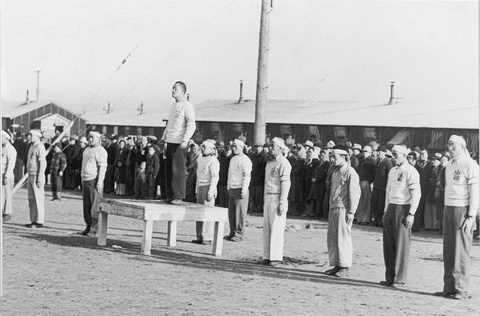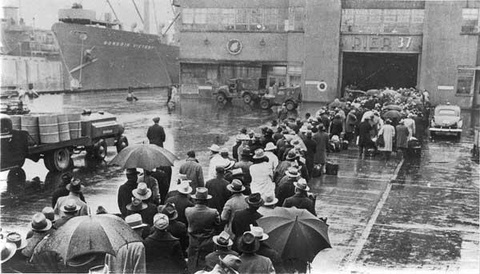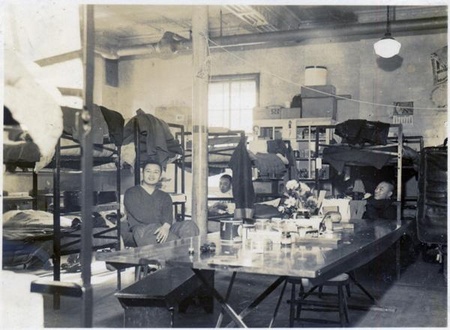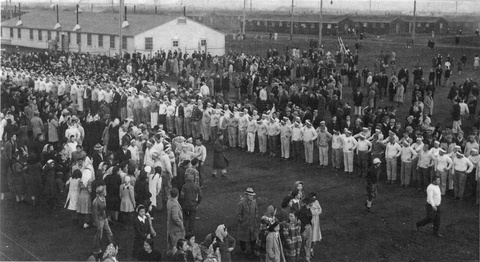Read Part 1 >>
Besides resistance to their being imprisoned and refusing army service, were there ever any acts of “disloyalty”/terrorism ever committed by these No-No Boys? If so, what?
That’s a big question this documentary engages, though the definition of “disloyalty”/terrorism is crucial. But the most important takeaway is, at every level, the rationale of “national security” was a complete sham. There were violent people in the camps just as there are in any prison. The more overcrowded and militarized Tule Lake became, the more violent it got, especially since the Caucasian administration did very little to stop the violent people. And the bombshell is that there were people who were pro-Japan in Tule Lake.
But being pro-Japan in that community had nothing to do with any plans to go sabotage a naval base. It was that Issei were forever barred from U.S. citizenship under the exclusion laws. With no prospect of having full membership in U.S. society, and citizenship itself looking pretty worthless from the inside of a concentration camp, the only real effect of being pro-Japan was having an affinity for the country you came from and where you were possibly going to end up after getting out of camp.

And then there were the Kibei, who were U.S.-born but had been educated in their youth for a time in Japan. There was a lot of prejudice and misinformation swirling around them, even within the JA community. The U.S. intelligence services saw them as inherently dangerous, and the Nisei who led the JACL (Japanese American Citizens League) scapegoated them too, even providing lists of their names to the FBI. Inside Tule Lake the young male Kibei tended to be associated with violence and vice versa. As deportation to Japan began to look likely, the Hoshi Dan formed as a group of young, mostly Kibei, who studied Japanese culture and ran around in early-morning, military-style drills as part of their preparation to return to Japan. Much of the writings on Tule Lake characterize the Hoshi Dan as “terrorists” who went around intimidating people into renouncing their citizenship and joining their ranks, and beating up people including Caucasian personnel. On the other hand, there are three people in my documentary who were members of the Hoshi Dan, and they didn’t participate in any violence. Also, my grandfather was Kibei. He was in the U.S. Army until they discharged him over his dual citizenship. So the Kibei and the Hoshi Dan need to be looked at with care and insight, they’re really the fulcrum for our understanding of Tule Lake.
Were others besides the “No-No Boys” and their families, sent to Tule Lake? What was the profile that the government was using?
Tule Lake started out as one of ten so-called “Relocation Centers” which held 110,000 Japanese Americans, which we now know were by definition concentration camps. They were run by a civilian agency, the War Relocation Authority. Tule Lake happened to be the camp where there were the highest number of “no-nos,” so the government repurposed that camp as Tule Lake Segregation Center and militarized it—added a battalion of Army to guard the outside, extra-high barbed wire fence, and even tanks. There were a lot of people there already who were “yes-yeses.” The WRA was originally going to separate out the yes-yes people and send them to the other camps, so you just had the no-nos in Tule Lake, but they decided it’d be too hard administratively. This fateful decision maximized the friction and conflict in the camp—it became, like Barbara Takei (member of the Tule Lake Committee) says in my film, “a pressure cooker.” There were so many divisive issues among this population made up of different factions of incarcerated Nikkei, including many of the boldest, most intelligent and least tolerant of racism and government stupidity.
How many were deported to Japan? Regarding the deportation, what was the process? Was there ever a real necessity to do this?

Tule Lake was a crucible that in effect turned citizens into enemy aliens. Renunciation was the culmination of the government’s whole mass incarceration program commonly called “the Internment of Japanese Americans.” In 1944-45, more than 5,000 Japanese Americans incarcerated at Tule Lake formally renounced their U.S. citizenship. More than a thousand of them actually expatriated to Japan, including people in this documentary. Why and how that happened is the most stunning and controversial question on this history. Congress passed the laws that made this possible, specifically with Tule Lake in mind. In the end, almost all of the renunciants changed their minds and successfully sued to get their citizenship back, though it took over twenty years. It was through the tireless, self-sacrificing work of one attorney—Wayne Collins—that the government’s effort to deport all these people was finally overcome. A couple of weeks ago I interviewed his son, also an attorney, who very much has carried his father’s torch—and I’m excited to share that story and historical insight.
Renouncing was not only about anger and betrayal, but sheer survival—with everything people locked up in this prison went through up to Japan’s surrender, Tule Lake Segregation Center and the country that devised it seemed a more hostile, dangerous place than a decimated post-war Japan where people were starving to death. Grace Hata, who was a teenager when all this was happening, saw dead bodies in the harbor when she arrived in Japan and dedicated all her smarts and charm to keeping her family alive. And today she lives in Los Angeles! The experience of Tule Lake is really transnational and shoots to hell the whole trumped-up notion of patriotic “loyalty” and citizenship that still dominates our discourse.
How much of a rift was there in the American JA community during WW2? Do these rifts still exist today?
As a yonsei, this is something I’m definitely still learning about. At this date, a lot of the people who lived through this history have passed on, but I’m sure of the survivors there are those who would still frown upon the “no-nos.” It seems that Japanese shame or reticence played a role in suppressing the whole experience of wartime incarceration to some extent for the first decades after World War Two. But a couple of my incarceree subjects told me they just didn’t have time to ponder or broadcast their experience too much because they were too busy getting their lives together after having everything taken away. But certainly mentioning you were in Tule Lake to other Japanese Americans was a socially perilous thing for some time. I’m sure many people carried the whole experience to their grave, which is doubly sad.
I think we can understand and honor all the choices that were made back then—there’s no one program that’s right or wrong. “Yes-yes” or “no-no” each had consequences, depending on what the family’s situation was, even what block in Tule Lake they lived on.
After Redress, were there any government apologies to the No-No Boys and their families?
In my understanding no-nos did receive reparations, with some limitations among the renunciants. The Redress is not a big focus of my film, but I would be really surprised if there was ever a formal apology to no-nos from the government, though there was a blanket apology to the incarcerated Japanese Americans. The fact that no-nos received reparations has been criticized by people opposed to Redress. You may remember some right-wing pundits who came out post-9/11 in support of the “internment” of Japanese Americans. They used no-nos as proof that racial incarceration was justified, and liked to sneer about these treacherous “disloyal” Japanese getting reparations.
One apology to the “no-nos” that has been discussed recently would be from the JACL. Though it’s now a completely different organization than it was then, in World War Two the JACL really stabbed no-nos in the back, along with the Kibei. I think it would be a meaningful gesture for them to apologize; hopefully it will happen while there are still living people to receive it.
Did Redress provide appropriate closure for those families?
It really varies, the reaction of Tule Lake incarcerees to the Redress. The one thing I think many would say in common is that they could have used the money much more right after incarceration than in the 1990s.
Did any ever return to the US?
Most of the renunciants who actually went to Japan did end up coming back to live in the U.S. In this documentary Grace Hata and Junichi Yamamoto take this odyssey in very different ways, which have to be heard to be believed.

Can you describe how your own thinking about the internment experience has evolved through your work on this project?
There’s been a lot of changes in my thinking really by just learning what’s going on with the Japanese American community who are engaged with this history.
The language itself is undergoing a conscious change: in 2013, the JACL passed a resolution called “The Power of Words” which corrects the euphemistic or incorrect language used in the past. And I’m afraid the generic term “internment” is in the crosshairs. The recommended words are now “incarceration” and “concentration camps.” Actually, internment is the confinement of non-citizens in time of war—that did happen to non-citizens of Japanese ancestry in World War Two, but it was a different detention system—the Department of Justice camps. It’s crucial to know the difference between incarceration and internment in dealing with Tule Lake, because many of my subjects’ dads were sent to actual internment camps, and when these Nisei renounced, they themselves went. So Resistance at Tule Lake will also be significant for clarifying these distinctions and using the correct terminology.
What does the story of TL say about American nationality and citizenship?
Dr. Satsuki Ina put it very well in the plenary session of the 2012 Tule Lake Pilgrimage, which focused on no-nos and renunciants: “We never had a crisis of loyalty…we had a crisis of faith in our government.”
Where is work on the documentary at this point?
This past summer I was awarded a grant from the Japanese American Confinement Sites program of the National Park Service. The documentary is set to be completed by the end of the year, with the community premieres happening at Day of Remembrance events in February 2016. We have all our main personal stories shot now, next we’ll be doing our expert interviews to provide the historical framework, including Tetsuden Kashima, who’s a chief authority on Tule Lake. Then we’ll be completing our archival research and editing the documentary, which will be a feature aimed for theatrical, public television, and educational distribution.
How can we as a community best help now?
The project needs all kinds of community involvement—we’re certainly interested in hearing about community venues to hold screenings. But to secure the JACS grant funds we need cash contributions to reach our required match of $50,000. Tax-deductible contributions can be made through this link. And the JACS grant gives a two for one match, meaning for every dollar you donate, the U.S. government gives two. There is a Facebook page for the documentary too.
Any final words?
Tule Lake has been a taboo subject for so long—to quote Barbara Takei, it’s been the “dirty laundry” of the JA community for 70 years. I was nervous about being involved in airing it out, but now I see the urgency of telling this story fully and well. After all we’ve learned since then, especially in the so-called War on Terror and whatever derivative era we’re currently living through—people are not only capable of grasping this rebellion, they really need to. There’s been too big a discrepancy between our ability to understand extremism and terrorism now, and our oversimplified understanding of the American concentration camps of World War Two. We really need to confront the extremities our national security system puts people through, from their point of view. And it’s not simply a story of oppression, but how people overcome it, staking all they truly own.

(Photo: R.H. Ross, WRA ’44-’46. Courtesy of the Tule Lake Committee)
* For more information about Konrad’s Tule Lake documentary, please check out resistanceattulelake.com.
© 2015 Norm Ibuki





